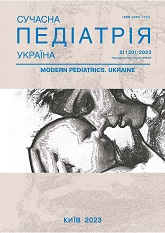Clinical features of the course of neonatal sepsis depending on the expressiveness of the body's inflammatory response
DOI:
https://doi.org/10.15574/SP.2023.130.67Keywords:
newborns, neonatal sepsis, C-reactive protein, presepsinAbstract
The study of the clinical features of the course of neonatal sepsis depending on the level of C-reactive protein and presepsin in the dynamics makes it possible to distinguish a cohort of children with a «severe» course of sepsis, who require complex monitoring of life-supporting functions.
Purpose - to study the clinical features of the course of neonatal sepsis and to distinguish the signs of «severe» sepsis for the purpose of an individualized approach to the choice of treatment tactics.
Materials and methods. 56 medical records of newborns with neonatal sepsis were analyzed. Depending on the level of the inflammatory response, two observation groups were formed. The clinical Group I included 25 patients with neonatal sepsis with a level of C-reactive protein (CRP) <20 mg/l (boys - 52.0%, city residents - 80.0%). The Group II was formed by 31 newborns with sepsis, in whom the content of CRP in the blood was >20 mg/l (boys - 62.8% (p>0,05), city residents - 57.1% (p>0,05)). The content of presepsin in the blood serum of newborns of both comparison groups exceeded 300 pg/ml. According to the main clinical characteristics, these groups were comparable. According to the time of manifestation of clinical signs of sepsis, the distribution by groups was gomogenous.
Results. A comprehensive clinical examination of newborns with neonatal sepsis on the 1st and the 3rd day of treatment gave reason to believe that signs of organ dysfunction are not associated with the severity of acute-phase indicators of the immunological response. However, on the 7th day of treatment, in patients with higher indicators of the inflammatory response, the preservation of signs of organ dysfunction, namely certain neurological, respiratory, hemodynamic disorders, changes in nutritional status, were noted.
Conclusions. A comprehensive clinical examination of newborns with neonatal sepsis in the dynamics revealed that the preservation of more pronounced signs of organ dysfunction is inherent in patients with higher inflammatory response rates on the 7th day of inpatient treatment. Based on the obtained data, it is shown that the cohort of children with neonatal sepsis was heterogeneous with certain characteristic features depending on immunological reactivity.
The research was carried out in accordance with the principles of the Declaration of Helsinki. The research protocol was approved by the Local Ethics Committee of the institution mentioned in the work. Informed consent of the parents was obtained for the research.
No conflict of interests was declared by the authors.
References
Bezrukov LO, Koloskova OK, Vlasova OV. (2017). Diahnostychne znachennia okremykh imunolohichnykh markeriv u veryfikatsii rannoho neonatalnoho sepsysu. Mizhnarodnyi zhurnal pediatrii, akusherstva ta hinekolohii. 11 (1): 5-13.
Dellinger RP, Levy MM, Rhodes A, Annane D, Gerlach H, Opal SM et al. (2013). Surviving Sepsis Campaign Guidelines Committee including the Pediatric Subgroup. Surviving sepsis campaign: international guidelines for management of severe sepsis and septic shock: 2012. Crit Care Med. 41 (2): 580-637. https://doi.org/10.1097/CCM.0b013e31827e83af; PMid:23353941
Haleka J, Novak M, Medkova A, Furstc T, Juranova J. (2019, Dec 16). The role of nCD64 in the diagnosis of neonatal sepsis in preterm newborns. Biomed Pap Med Fac Univ Palacky Olomouc Czech Repub. 162 (4): 284-288. URL: https://biomed.papers.upol.cz/pdfs/bio/2018/04/06.pdf. https://doi.org/10.5507/bp.2018.033; PMid:29955185
Henry CJ, Semova G, Barnes E et al. (2022). Neonatal sepsis: a systematic review of core outcomes from randomized clinical trials. Pediatric Research. 91: 735-742. https://doi.org/10.1038/s41390-021-01883-y; PMid:34997225 PMCid:PMC9064797
Khanes GS, Maksakova IS, Grimalskaya AO, Rybalchenko IG, Zhernov AA. (2022). Experience in the treatment of neonatal colie-klebsiellosis sepsis complicated by soft tissue necrosis of the scalp. Paediatric Surgery (Ukraine). 2(75): 96-100. https://doi.org/10.15574/PS.2022.75.96
Koloskova OK, Kretsu NM. (2022). Diagnostics of septic myocardial dysfunction in neonates. Modern Pediatrics. Ukraine. 5: 19-25. https://doi.org/10.15574/SP.2022.125.19
Loncarica GK, Fustiñana A, Jabornisky R. (2019). Recommendations for the management of pediatric septic shock in the first hour (part I). Arch Argent Pediatr. 117 (1): 14-23. https://doi.org/10.5546/aap.2019.eng.e14
Newman TB, Puopolo KM, Wi S, Draper D, Escobar GJ. (2010). Interpreting complete blood counts soon after birth in newborn at risk for sepsis. Pediatrics. 126 (5): 903-909. https://doi.org/10.1542/peds.2010-0935; PMid:20974782 PMCid:PMC3197862
Pavlushkyna LV, Fylatova NF, Chernevskaia EA, Dmytryeva YB, Beloborodova NV. (2013). Byomarkery v klinichnii praktytsi. Laboratoriia. Spetsvyp. 3: 10-14.
Poggi C, Bianconi T, Gozzini E, Generoso M, Dani C. (2015). Presepsin for the detection of late-onset sepsis in preterm newborns. Pediatrics. 135 (1): 68-75. https://doi.org/10.1542/peds.2014-1755; PMid:25511124
Shunko YeIe (red). (2015). Neonatolohiia. Natsionalnyi pidruchnyk. Kyiv: 93-138.
Simonsen KA, Anderson-Berry AL, Delair SF, Davies HD. (2014, Jan). Early-onset neonatal sepsis. Clin Microbiol Rev. 27 (1): 21-47. https://doi.org/10.1128/CMR.00031-13; PMid:24396135 PMCid:PMC3910904
Tzialla C, Manzoni P, Achille C, Bollani L, Stronati M, Borghesi A. (2018, Dec 17). New Diagnostic Possibilities for Neonatal Sepsis. Am J Perinatol. 35 (6): 575-577. URL: https://www.thieme-connect.com/products/ejournals/abstract/10.1055/s-0038-1639361. https://doi.org/10.1055/s-0038-1639361; PMid:29695000
Webbe JWH et al. (2020). Inconsistent outcome reporting in large neonatal trials: a systematic review. Arch. Dis. Child Fetal Neonatal Ed.: 69-75. https://doi.org/10.1136/archdischild-2019-316823; PMid:31085676
Zou Q, Wen W, Zhang XC. (2014). Presepsin as a novel sepsis biomarker. World J Emerg Med. 5 (1): 16-19. https://doi.org/10.5847/wjem.j.issn.1920-8642.2014.01.002; PMid:25215141 PMCid:PMC4129857
Downloads
Published
Issue
Section
License
Copyright (c) 2023 Modern pediatrics. Ukraine

This work is licensed under a Creative Commons Attribution-NonCommercial 4.0 International License.
The policy of the Journal “MODERN PEDIATRICS. UKRAINE” is compatible with the vast majority of funders' of open access and self-archiving policies. The journal provides immediate open access route being convinced that everyone – not only scientists - can benefit from research results, and publishes articles exclusively under open access distribution, with a Creative Commons Attribution-Noncommercial 4.0 international license (СС BY-NC).
Authors transfer the copyright to the Journal “MODERN PEDIATRICS. UKRAINE” when the manuscript is accepted for publication. Authors declare that this manuscript has not been published nor is under simultaneous consideration for publication elsewhere. After publication, the articles become freely available on-line to the public.
Readers have the right to use, distribute, and reproduce articles in any medium, provided the articles and the journal are properly cited.
The use of published materials for commercial purposes is strongly prohibited.

